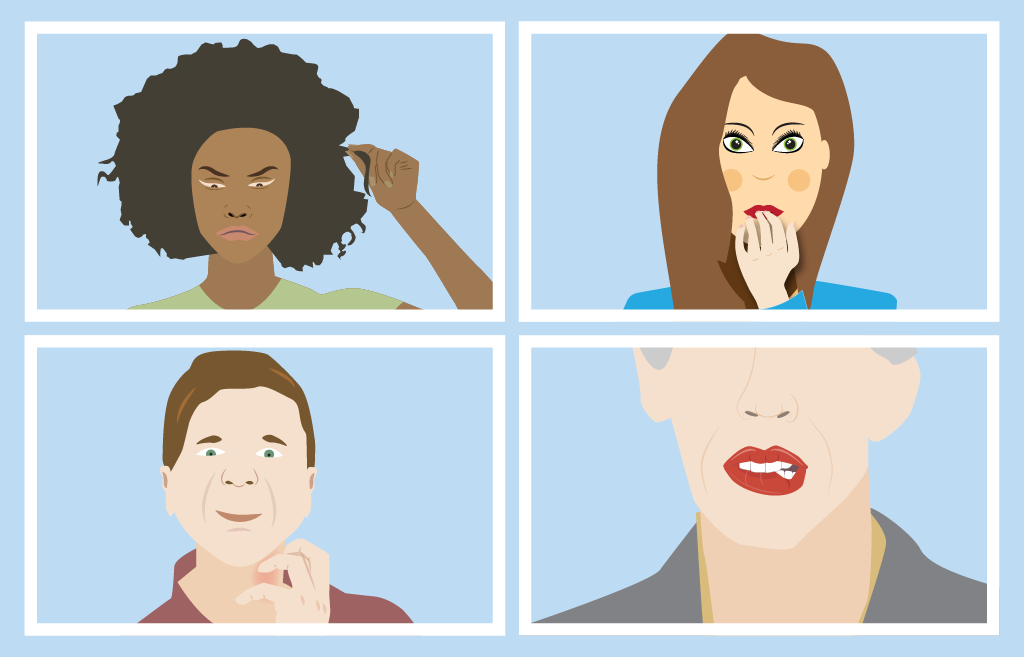Treatment Guide for Body-Focused Repetitive Behaviors

Introduction
The self-help techniques presented here are aimed at individuals suffering from body-focused repetitive behaviors (BFRBs). The techniques described below have been scientifically validated as effective (Farhat et al., 2020; Moritz & Rufer, 2011; Moritz et al., 2011; Moritz et al., in press; Sarris et al., 2012). Please note that the techniques are also illustrated in a video on this website. Importantly, no drug has yet been approved for the treatment of BFRBs and the few existing studies of potential drugs to treat BFRBs (Farhat et al., 2020) have had inconsistent results, so the techniques presented here may be considered the gold standard at this time.
BFRBs include the compulsive pulling out of one’s hair, for example on the head, pubic area or eyelashes. This is also called trichotillomania (see Figure 1a).
Biting one’s lips, tongue, or oral mucosa (the mucous membrane lining the inside of the mouth) is also a common impulse-control disorder.
Many people also tend to scratch or pick at pimples or blemishes on the skin (see Figure 1b).
Nail biting and biting the cuticles are also BFRBs (see Figure 1c).



The photographers of these and other photos are credited on the final page.
BFRBs can be focused, meaning there are intentional behaviors. Common triggers include itchy skin, hangnails, or perhaps a gray or annoying hair. However, for many people, the behavior has a life of its own and happens automatically. This means that the behavior is often performed without conscious awareness.
BFRBs can lead to a number of other psychological and physical problems. Those affected may experience feelings of shame, leading them to withdraw from others due to, for example, bald patches on their head or unsightly fingernails. They may also avoid common social situations like shaking hands. Skin picking in particular can leave scars, and compulsive nail biting may cause inflammation, which in turn can impair nail growth. Pulling out one’s hair can lead to problems with regrowth. However, simply knowing about these possible consequences is often not enough for many affected individuals to kick their annoying habit. Many people feel like they’re at the mercy of their behaviors.
This text will introduce you to three techniques that you can use on your own to reduce impulse-control disorders. We’ll go over the techniques one by one. The technique you choose to start with will be up to you. In one study, the best results were achieved when starting with the second technique (i.e., decoupling). You can use the techniques separately or combine them. See what is most successful for you.
In our illustrations of the techniques, we focus mainly on hair pulling and nail biting, but these techniques can be very easily adapted—with a little imagination—to other problem areas.
Before we describe the three techniques, it’s important that you have a good understanding of the times and situations in which you tend to engage in the unwanted behavior.
Observing/keeping a log of your unwanted behavior
Most people with impulse-control disorders don’t execute their behavior 24/7 but instead do so in specific situations, like when they’re stressed, or while reading or answering emails, or when they’re under the covers at night. Often, the behavior tends to occur at specific times of the day.
With this in mind, carefully record your behavior for a few days. You can also ask those close to you to give you feedback about when you bite your nails, pull out your hair, pick at your skin, or perform other unwanted behaviors. Make yourself a chart similar to this example for skin picking:
| Location/Time | Activity | Feeling | Resulting Behavior |
| Desk | Checking emails under time pressure | Stressed | More touching of my skin |
| Office | Phone call with mom | Annoyed | Increased rubbing of certain areas of my skin |
| Living room/evening | Watching TV alone on the couch | Bored | More picking at my skin due to boredom or because I feel alone |
| … | … | … | … |
Record specific situations in the table, taking note of the time of day. Also indicate which problem behavior you engage in. Don’t actively intervene yet; just try to observe your actions as neutrally as possible.